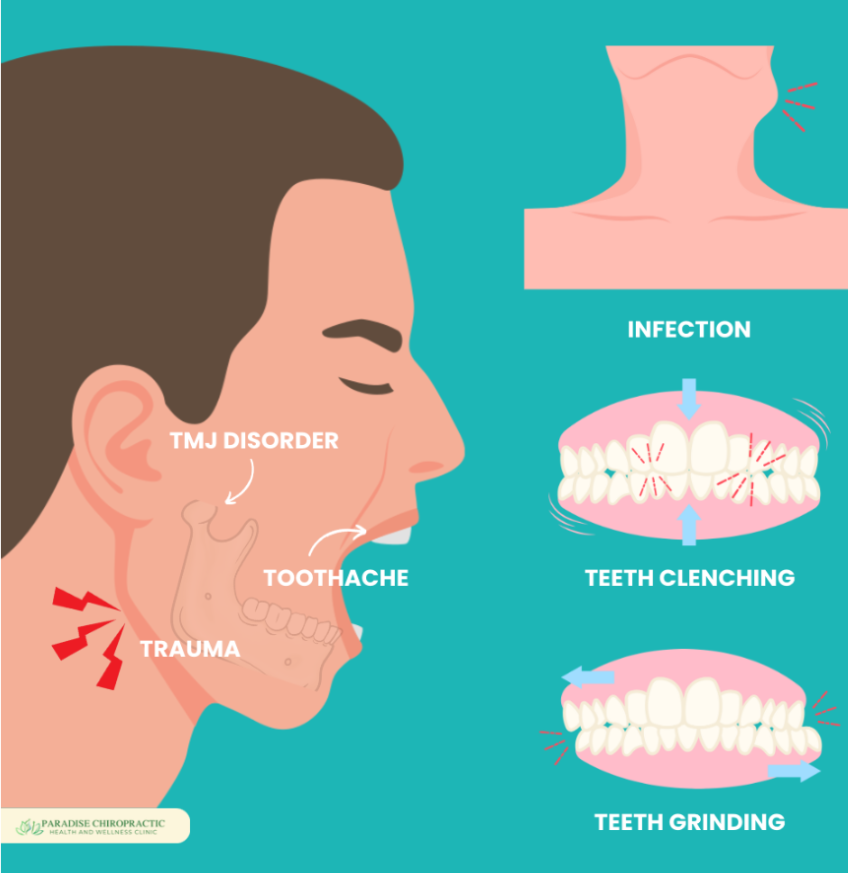
|
Dr. Kimberly Huynh D.C. |
|
|
November 28, 2024 · 7 min |

The jaw is a highly active joint, essential for everyday functions like talking, eating, and drinking. Hence when jaw pain arises it can be more than a nuisance. Jaw pain affects 5-12% of the general population, affecting women more than men. According to the National Institutes of Health, TMJ pain is “occasional and temporary, often occurring in cycles” with some individuals developing significant, long-term symptoms. Temporomandibular disorders (TMD) is a blanket term used for jaw pain and dysfunction by problems with the joint or its associated musculature. The temporomandibular joint (TMJ) is composed of the temporal bone (the upper joint) and mandibular bone (the lower joint) separated by the disc. Opening biomechanics includes the lower joint hinging and the upper joint sliding together. Jaw movement involves various muscles including the temporalis, masseter, medial and lateral pterygoids. These are known as the muscles of mastication (chewing). When the muscles are dysfunctional this can prevent the movement of the jaw in a coordinated fashion.
TMJ disorder has a variety of causes.
Some common causes and risks include:
- Muscle pain from the muscles controlling jaw movement, or connected areas (neck and shoulder muscles)
- Teeth grinding and clenching (bruxism)
- Direct trauma including jaw dislocation, head or neck injury
- Internal disorder of the joint, or a dislocated or displaced disc.
- Degenerative joint disease in the jaw joint, like arthritis
- Lifestyle factors such as stress, poor posture, and oral habits
- Infection
- Dental problems such as malocclusion and bite issues

- Pain in the jaw and/or face
- Jaw muscle stiffness
- Chronic headaches
- Limited mouth opening (locked jaw)
- Discomfort while chewing or biting
- Facial swelling due to inflammation
- Grating, popping, or clicking sounds with jaw movement
- A change in the upper and lower teeth fit together (bite)
Conservative treatments for the TMJ are often the initial steps for pain relief. Chiropractic treatment starts with a thorough medical history taken, followed by a physical examination of the TMJ, neck, and surrounding structures. This includes observation of the jaw, assessing mandibular movement, and performing specific orthopedic tests. Treatment typically involves targeted soft tissue therapy, gentle chiropractic adjustments, rehabilitation exercises, and education on lifestyle including activities to avoid and incorporate.
Here are some steps you can do to in easing TMD symptoms:
- Stress-control
- Avoid extreme jaw movement (wide yawning, loud singing, chewing gum)
- Avoiding chewy and hard foods, and opting for softer food choices
- Identifying and avoiding any activities that add strain to the jaw
- Applying cold compresses (to reduce inflammation and manage discomfort)
- Limiting or avoiding pounding sports (running, soccer, and basketball)
- Limiting or avoiding smoking
- Holding the phone against the face
These requests may come when talking to your healthcare provider.
The following TMJ rehab may be prescribed including muscle release and specific jaw opening and strengthening exercises to offer relief.
1. Chin Retraction - Start in a standing or seated position with your shoulders back and chest forward. Pull your neck and chin back to create a “double chin.” Hold this position for five seconds. Repeat 3 to 5 times.
2. Tongue press hold - Press tip of tongue to hard palette and hold for 5 seconds. Repeat 3 to 5 times.
3. Jaw protraction - Sit or stand up straight, with your shoulders relaxed. Slowly move your lower jaw forward as far as is comfortable, aiming to align the bottom front teeth with the top front teeth. Hold this protracted position for 5 seconds, feeling a stretch in the jaw muscles. Gradually return to the neutral position. Repeat 3 to 5 times.
4. Resisted mouth opening - Place two fingers under your chin and apply gentle pressure as you slowly open your mouth. Hold this position for 3 to 5 seconds before closing your mouth.Repeat 3 to 5 times.
5. Masseter release - Place two fingers on the TMJ and gently apply sustained pressure. Slowly open mouth. Release fingers and gently close mouth. Repeat 3 to 5 times.
If your symptoms do not improve with self care practices, please consult with your health practitioner for proper diagnosis and treatment and further referral if needed. We are accepting new patients and are happy to help you get relief from your jaw pain with our safe and gentle treatments.
CCA. (2022, May 25). 3 things you need to know about TMJ pain. Canadian Chiropractic Association (CCA) - Association chiropratique canadienne. Retrieved June 10, 2022, from https://chiropractic.ca/blog/3-things-you-need-to-know-about-tmj-pain/
Pavia, S., Fischer, R., & Roy, R. (2015). Chiropractic Treatment of Temporomandibular Dysfunction: A Retrospective Case Series. Journal of chiropractic medicine, 14(4), 279–284. https://doi.org/10.1016/j.jcm.2015.08.005
National Institute of Dental and Craniofacial Research. (2017). *TMJ disorders*. U.S. Department of Health and Human Services, National Institutes of Health. https://www.nidcr.nih.gov/sites/default/files/2017-12/tmj-disorders.pdf
U.S. Department of Health and Human Services. (n.d.). Prevalence of TMJD and its signs and symptoms. National Institute of Dental and Craniofacial Research. Retrieved June 10, 2022, from https://www.nidcr.nih.gov/research/data-statistics/facial-pain/prevalence